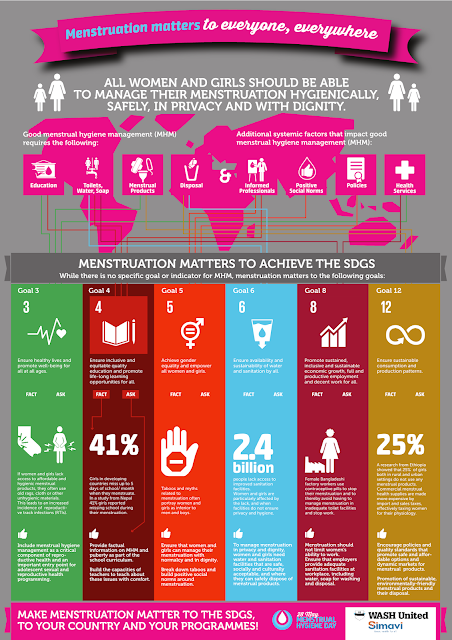- To address the challenges and hardships many women and girls face during their menstruation.
- To highlight the positive and innovative solutions being taken to address these challenges.
- To catalyze a growing, global movement that recognizes and supports girl’s and women’s rights and build partnerships among those partners on national and local level.
- To engage in policy dialogue and actively advocate for the integration of MHM into global, national and local policies, programs and projects.
- It creates an occasion for media work, including social media.
Menstruation, also known as a period or monthly is the regular discharge of blood and mucosal tissue from the inner lining of the uterus through the vagina.
Menstruation is a phenomenon unique to the females. The onset of menstruation is one of the most important changes occurring among the girls during the adolescent years.
Menstruation is a natural part of the reproductive cycle.
The first menstruation (menarche) occurs between 11 and 15 (mean of 13) years.
The menstrual cycle occurs due to the rise and fall of hormones.
This cycle results in the thickening of the lining of the uterus, and the growth of an egg, (which is required for pregnancy).
- “Women and adolescent girls use a clean material to absorb or collect menstrual blood, and this material can be changed in privacy as often as necessary for the duration of menstruation.
- MHM also includes using soap and water for washing the body as required; and having access to facilities to dispose of used menstrual management materials.
Menstrual Hygiene Management in Nepal
- Every day approximately 290000 women and girls in Nepal menstruate!!
- 82% of Nepali women living in rural Nepal, use of unhygienic, un-healthy and possibly dangerous menstrual hygiene management methods push Nepali women deeper into the crevice of marginalization and reproductive health morbidity.
- Young adolescent girls constitute a particularly vulnerable group. Studies have shown that adolescent girls often lack appropriate information about their reproductive health and proper menstrual management which has a direct impact upon adolescent girl’s schooling, with absenteeism of menstruating girls as high as 53% in Nepal.
- This frequent absence from school implies an average annual absence of at least six weeks from school directly affecting girl’s academic progress.
- Unsatisfactory academic progress coupled with the societal belief that girls who have started menstruating are eligible for marriage, contributes to high dropout rates from school and early marriage, which itself is a risk factor preventing optimum reproductive health, birthing practices, birth spacing and healthy children.
- Educating girls about menstruation helps increase self esteem, raise grades and raise wages.
- Learning about menstruation empowers girls to take care of themselves in brand new ways.
- Learning and understanding what menstrual hygiene options exist for them gives girls the opportunity to choose what solution is best for them.
- It gives girls and women confidence to live their lives normally.
- Talking about menstrual hygiene before menarche (the first period) is very important for ensuring that girls know how to handle the often scary first period.
- Understanding how tampons, menstrual cups, or other sanitary materials work allows girls to explore their bodies in new and important ways.’
- Proper menstrual hygiene keeps girls in school.
- Access to menstrual hygiene products keep girls on the same track as their male peers.
- It keeps women at work, contributing to economic development.
- Educating girls and women about feminine hygiene and biology helps to bust myths and cultural superstitions.
- Access to correct information about hygiene and adequate sanitary materials enables women to feel more confident and comfortable with their bodies.
- Debunking myths and taboos can keep girls and women safe. (Chaupadi)
- It helps women realize that they are not impure.
- Educating men and boys about menstruation can help men develop higher levels of understanding of women and girls’ bodies and needs.
- Learning about menstrual hygiene management helps ensure cleanliness.
- Knowing what product or material to use, how often to change it, and having access to WASH (water, sanitation and hygiene) facilities helps girls and women maintain good hygiene while menstruating.
- It helps keep Bacterial Vaginosis (bacterial vaginal infections) away, It can help prevent girls and women from getting toxic shock syndrome (TSS)
- It helps reduce the likelihood of getting cervical cancer.
ying the disease believe poor menstrual hygiene is partly to blame.



